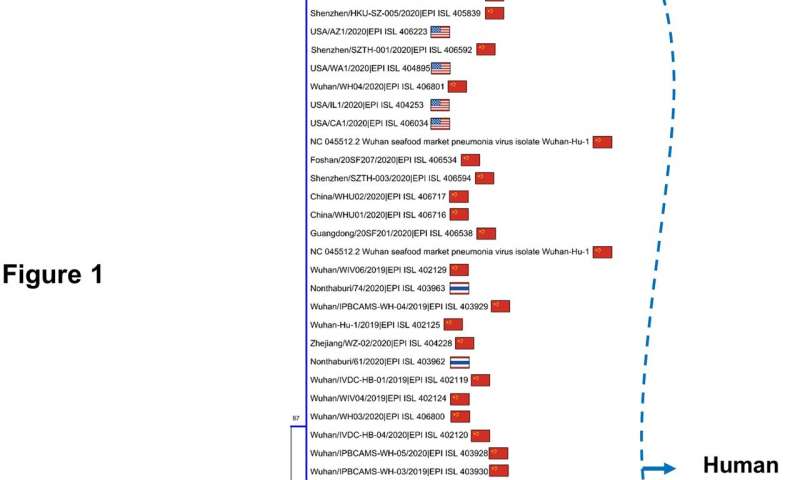Largest Meta-Analysis Of Sequenced Genomes Of The Coronavirus Reveals A New Subtype Has Emerged
Source: Thailand Medical News Feb 08, 2020 5 years, 10 months, 9 hours, 32 minutes ago
While many medical experts are denying that the new 2019n-CoV
coronavirus has mutated or can mutate, a new meta-analysis based on a detailed study of all known genomes sequenced from samples collated from all infected patients from around the world have revealed a disturbing fact that many medical experts and health organizations are refusing to make known to the public, the
coronavirus has a new subtype that has emerged since its first debut in December 2019.

This has various implications and also confirm that the
coronavirus is indeed evolving and mutating and that too at a fast rate considering that its only about 4 weeks or so since the first genome was sequenced, that already a subtype is gradually emerging.
The detailed genome study identified for the first time a hyper-variable hotspot in the virus proteins, eventually pinpointing two virus subtypes. The latter differ only by a single amino acid, which is able to change the sequence and the structure of ORF8-encoded protein, a virus component yet to be characterized.
The study is already published in the Journal of Medical Virology and we at Thailand Medical news would like to see which medical ‘experts’ or health organizations would disputes this claim.(though they will just merely avoid talking about it)
This largest analysis of
coronavirus 2019-nCoV genomes that have been sequenced so far also confirms that the virus originates in bats and shows a low virus heterogeneity.
The leading author of this study, is Dr Federico M. Giorgi, bioinformatics researcher at the Department of Pharmacy and Biotechnology of the University of Bologna.
This recent study analyzed the genomes of the 56
coronavirus strains sequenced in different parts of the world, including those extracted from the two Chinese patients held at the Infectious Disease Ward of Lazzaro Spallanzani Hospital in Rome, Italy.
 Phylogenetic tree of all the 2019-nCov sequences available at 02-Feb-2020 (branches shown in blue), plus six Bat coronavirus sequences (default black, as they are split in multiple taxa), six Human SARS (green) and 2 MERS (orange). The percentage of bootstraps supporting each branch is reported. Branches corresponding to partitions reproduced in less than 50% bootstrap replicates are collapsed. Credit: University of Bologna
Phylogenetic tree of all the 2019-nCov sequences available at 02-Feb-2020 (branches shown in blue), plus six Bat coronavirus sequences (default black, as they are split in multiple taxa), six Human SARS (green) and 2 MERS (orange). The percentage of bootstraps supporting each branch is reported. Branches corresponding to partitions reproduced in less than 50% bootstrap replicates are collapsed. Credit: University of Bologna
This research is the most comprehensive study of
coronavirus genomes so far conducted.
The researcher also confirmed the notion that the virus probably originates from a zoonotic pathogen: its closest relative, which was isolated in the past few weeks, matches the
<
span style="font-size:14px">coronavirus sequence EPI_ISL_402131 found in the Rhinolophus affinis, a medium-size Asian bat of the Yunnan Province (China).
The human
coronavirus genome shares at least 96.2% of its identity with its bat relative, while its similarity rate with the human strain of the SARS virus (severe acute respiratory syndrome) is much lower, only 80.3%. This too has implications with regards to the behavior of the new
coronavirus.
The bioinformatic , genomic and virology researchers have also discovered that all the existing DNA sequences of
coronavirus are very similar, even if they come from different regions of China and from various parts of the world ie the genomes obtained from patients since the beginning of the outbreak share a sequence identity over 99%.
Dr Federico M. Giorgi explained, "The
coronavirus shows low heterogeneity and variability, this is good news. With a homogeneous viral population, potential drug therapies are deemed to be more effective on everyone."
However many genomic and virology experts are saying that a subtype already appearing so fast might not indicate anything good, rather the contrary.
Reference: Carmine Ceraolo et al. Genomic variance of the 2019‐nCoV coronavirus, Journal of Medical Virology (2020). DOI: 10.1002/jmv.25700
For more updates about the
coronavirus epidemic or the
Thailand Coronavirus scenario, keep on checking at:
https://www.thailandmedical.news/articles/coronavirus

